Garner (919) 661-4150
August 2022
Big Toe Stretches
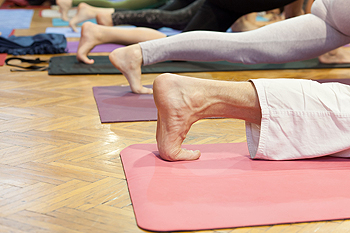
Having foot and ankle pain is common among many people. The feet will feel better when they are frequently stretched. They will also have increased flexibility and range of motion. It is suggested that stretching the feet become part of a daily exercise regime, and there are simple methods that can be implemented to accomplish this. An effective stretch is known as the toe raise, point, and curl, and it is divided into three stages. It is started by sitting in a chair, and raising the heels while the toes are on the floor. The second phase consists of raising the heels, and positioning the toes so the tops of the big and second toe are on the floor. It ends by raising the heels, and curling the toes inward. Mobility may be increased when this is frequently practiced. Additionally, to stretch the big toe, bring the left foot to rest on the right thigh. Manually pull the big toe into an up position, and then down, and repeat several times. It is important to stretch the feet often. If you would like more information about effective foot stretches, please consult with a podiatrist.
Why Stretching Is Important for Your Feet
Stretching the feet is a great way to prevent injuries. If you have any concerns with your feet consult with Chukwuma Ukata, DPM from Advanced Carolina Foot and Ankle Center. Our doctor will assess your condition and provide you with quality foot and ankle treatment.
Stretching the Feet
Stretching the muscles in the foot is an important part in any physical activity. Feet that are tight can lead to less flexibility and make you more prone to injury. One of the most common forms of foot pain, plantar fasciitis, can be stretched out to help ease the pain. Stretching can not only ease pain from plantar fasciitis but also prevent it as well. However, it is important to see a podiatrist first to determine if stretching is right for you. Podiatrists can also recommend other ways to stretch your feet. Once you know whether stretching is right for you, here are some excellent stretches you can do.
- Using a foam roller or any cylindrical object (a water bottle or soda can will do), roll the object under your foot back and forth. You should also exert pressure on the object. Be sure to do this to both feet for a minute. Do this exercise three times each.
- Similar to the previous exercise, take a ball, such as a tennis ball, and roll it under your foot while seated and exert pressure on it.
- Grab a resistance band or towel and take a seat. If you are using a towel, fold it length wise. Next put either one between the ball of your foot and heel and pull with both hands on each side towards you. Hold this for 15 seconds and then switch feet. Do this three times for each foot.
- Finally hold your big toe while crossing one leg over the other. Pull the toe towards you and hold for 15 seconds. Once again do this three times per foot.
It is best to go easy when first stretching your foot and work your way up. If your foot starts hurting, stop exercising to ice and rest the foot. It is advised that you then see a podiatrist for help.
If you have any questions, please feel free to contact our office located in Garner, NC . We offer the newest diagnostic and treatment technologies for all your foot care needs.
Different Types of Hammertoe
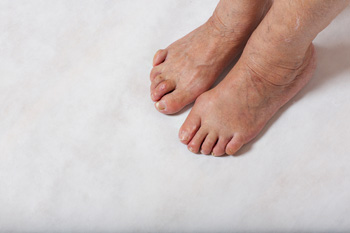
Of all the afflictions that can detrimentally affect the feet, some can manipulate the toes and the way that they function. Hammertoe is one such foot condition. An individual can develop hammertoe when the second, third, or fourth toe essentially points upward at the first toe joint. This condition is called hammertoe because the affected toe begins to resemble a hammer. There are two primary types of hammertoe. First, you may develop flexible hammertoe where the affected joint can still be moved. This is arguably the less severe case of hammertoe, because it can sometimes be treated by making simple adjustments, such as being more mindful of the footwear that one chooses. Second, you may develop rigid hammertoe, which restricts the individual from moving the affected toe joint. In some cases of rigid hammertoe, the condition can only be addressed through surgery. There are a variety of surgical procedures that might be used to address rigid hammertoe. For example, a medical professional might choose to perform a tendon transfer, joint resection, or fusion. If you suspect that you might have a hammertoe, reach out to a podiatrist who will be able to diagnose and treat the problem.
Hammertoe
Hammertoes can be a painful condition to live with. For more information, contact Chukwuma Ukata, DPM from Advanced Carolina Foot and Ankle Center. Our doctor will answer any of your foot- and ankle-related questions.
Hammertoe is a foot deformity that affects the joints of the second, third, fourth, or fifth toes of your feet. It is a painful foot condition in which these toes curl and arch up, which can often lead to pain when wearing footwear.
Symptoms
- Pain in the affected toes
- Development of corns or calluses due to friction
- Inflammation
- Redness
- Contracture of the toes
Causes
Genetics – People who are genetically predisposed to hammertoe are often more susceptible
Arthritis – Because arthritis affects the joints in your toes, further deformities stemming from arthritis can occur
Trauma – Direct trauma to the toes could potentially lead to hammertoe
Ill-fitting shoes – Undue pressure on the front of the toes from ill-fitting shoes can potentially lead to the development of hammertoe
Treatment
Orthotics – Custom made inserts can be used to help relieve pressure placed on the toes and therefore relieve some of the pain associated with it
Medications – Oral medications such as anti-inflammatories or NSAIDs could be used to treat the pain and inflammation hammertoes causes. Injections of corticosteroids are also sometimes used
Surgery – In more severe cases where the hammertoes have become more rigid, foot surgery is a potential option
If you have any questions please contact our office located in Garner, NC . We offer the newest diagnostic and treatment technologies for all your foot and ankle needs.
Why Live with Pain and Numbness in Your Feet?
Why Do I Have Foot Pain?
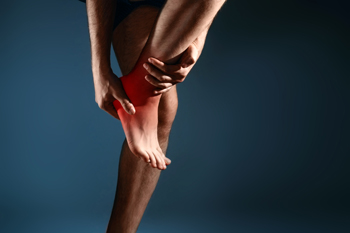
The foot is one of the most important parts of the human body. Not only is it responsible for bearing the weight of your body, but it is also central to movement such as walking and running. When you experience foot pain it is nothing to take lightly, and your body may be indicating something isn’t right. There could be several reasons why your foot is hurting. First, you might be having foot pain as a result of a fungal infection. For example, you may have developed a condition known as athlete’s foot, which makes the affected skin flaky and itchy. Second, you could be suffering from an overuse injury. This commonly occurs in athletes who repeatedly put pressure and strain on their feet when running and jumping. Third, you might be experiencing foot pain because of a fracture. Bones in the feet can become fractured, or broken, when heavy objects are dropped on the feet or when being subject to repeated trauma. If your feet are hurting, contact a podiatrist.
Foot Pain
Foot pain can be extremely painful and debilitating. If you have a foot pain, consult with Chukwuma Ukata, DPM from Advanced Carolina Foot and Ankle Center. Our doctor will assess your condition and provide you with quality foot and ankle treatment.
Causes
Foot pain is a very broad condition that could be caused by one or more ailments. The most common include:
- Bunions
- Hammertoes
- Plantar Fasciitis
- Bone Spurs
- Corns
- Tarsal Tunnel Syndrome
- Ingrown Toenails
- Arthritis (such as Gout, Rheumatoid, and Osteoarthritis)
- Flat Feet
- Injury (from stress fractures, broken toe, foot, ankle, Achilles tendon ruptures, and sprains)
- And more
Diagnosis
To figure out the cause of foot pain, podiatrists utilize several different methods. This can range from simple visual inspections and sensation tests to X-rays and MRI scans. Prior medical history, family medical history, and any recent physical traumatic events will all be taken into consideration for a proper diagnosis.
Treatment
Treatment depends upon the cause of the foot pain. Whether it is resting, staying off the foot, or having surgery; podiatrists have a number of treatment options available for foot pain.
If you have any questions, please feel free to contact our office located in Garner, NC . We offer the newest diagnostic and treatment technologies for all your foot care needs.
Heel Pain, Plantar Fasciitis, and Obesity May Be Connected
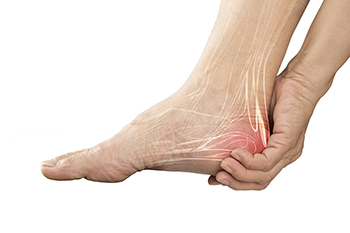
Research has indicated there is a large percentage of Americans that are considered to be obese. This condition is known to increase the risk of many physical ailments, including heel pain and plantar fasciitis. It can happen as a result of the added impact the feet endure from completing daily activities, and this may possibly damage the plantar fascia. This is defined as the band of tissue that runs along the bottom of the foot, and connects the heels to the toes. Walking can become difficult, and heel pain may increase. Partial relief may be found when a low-impact exercise routine is frequently followed. This type of exercise can include swimming, water aerobics or cycling, and some patients can feel the benefits of practicing yoga and Pilates as part of their exercise regime. This, along with eating foods that are healthy, are often effective ways to lose weight, which may relieve some of the pressure on the plantar fascia. If you have any type of foot pain, and feel your weight may be a contributing factor, please speak with a podiatrist who can treat foot conditions, and offer additional solutions for weight loss.
The more you weigh, the harder your feet must work to support your body. If you’re an obese individual and are concerned about your feet, contact Chukwuma Ukata, DPM from Advanced Carolina Foot and Ankle Center. Our doctor can provide the care you need to keep you pain-free and on your feet.
Obesity and Your Feet
People who are overweight are putting more pressure on their ankles, knees, and hips as well as their feet. This unfortunately can lead to variety of different issues.
Problems & Complications Stemming from Obesity
- When the body is overweight, it tries to compensate by changing the way that it moves. An obese person may lean forward and put extra weight on the wrong part of the foot. This puts unnecessary stress on the feet.
- Obese people are also more likely to develop type II diabetes which is a condition that causes a lot of foot problems. People with diabetes often don’t feel the cuts and sores that they may have on their feet, which can lead to more complicated and severe issues.
- Plantar fasciitis is another foot condition that can be caused by obesity. Plantar fasciitis is an inflammation of the tissue along the bottom of the foot, which causes pain and stiffness while walking and climbing stairs.
If you have any questions, please feel free to contact our office located in Garner, NC . We offer the newest diagnostic and treatment technologies for all your foot care needs.
What Is Cuboid Syndrome?
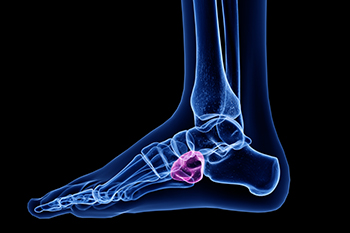
Cuboid syndrome is a condition that involves a disruption of the normal alignment of the cuboid bone with the heel bone, and it causes pain on the outside of the foot. The pain might feel like it originates from the outside of the ankle, and the person afflicted with it may limp or sway when walking to avoid placing weight on the affected area. Mild swelling or bruising might be seen on the outside and bottom of the mid-foot. This problem develop from a single event, such as an ankle sprain, or through repetitive impact to the area, like runners or dancers (particularly ballet dancers) might experience. A small “popping” might be felt on the outside of the mid-foot as well. Treatment of cuboid syndrome usually involves making sure shoes are well-fitting and comfortable, using soft orthotics, and doing stretching exercises to help mobilize the joint. In some instances, realignment of the cuboid bone is needed. If you feel pain in your mid-foot area and it is worsening, you might have a more severe case of cuboid syndrome. You can see a podiatrist who can properly diagnose the problem and provide appropriate treatment.
Cuboid syndrome, also known as cuboid subluxation, occurs when the joints and ligaments near the cuboid bone in the foot become torn. If you have cuboid syndrome, consult with Chukwuma Ukata, DPM from Advanced Carolina Foot and Ankle Center. Our doctor will assess your condition and provide you with quality foot and ankle treatment.
Cuboid syndrome is a common cause of lateral foot pain, which is pain on the outside of the foot. The condition may happen suddenly due to an ankle sprain, or it may develop slowly overtime from repetitive tension through the bone and surrounding structures.
Causes
The most common causes of cuboid syndrome include:
- Injury – The most common cause of this ailment is an ankle sprain.
- Repetitive Strain – Tension placed through the peroneus longus muscle from repetitive activities such as jumping and running may cause excessive traction on the bone causing it to sublux.
- Altered Foot Biomechanics – Most people suffering from cuboid subluxation have flat feet.
Symptoms
A common symptom of cuboid syndrome is pain along the outside of the foot which can be felt in the ankle and toes. This pain may create walking difficulties and may cause those with the condition to walk with a limp.
Diagnosis
Diagnosis of cuboid syndrome is often difficult, and it is often misdiagnosed. X-rays, MRIs and CT scans often fail to properly show the cuboid subluxation. Although there isn’t a specific test used to diagnose cuboid syndrome, your podiatrist will usually check if pain is felt while pressing firmly on the cuboid bone of your foot.
Treatment
Just as the range of causes varies widely, so do treatments. Some more common treatments are ice therapy, rest, exercise, taping, and orthotics.
If you have any questions, please feel free to contact our office located in Garner, NC . We offer the newest diagnostic and treatment technologies for all your foot care needs.







